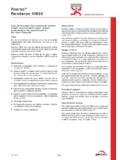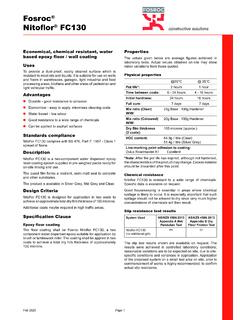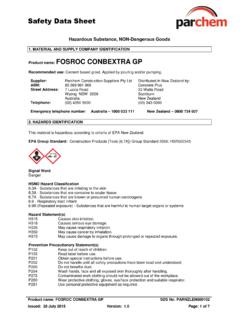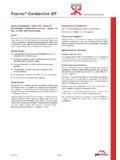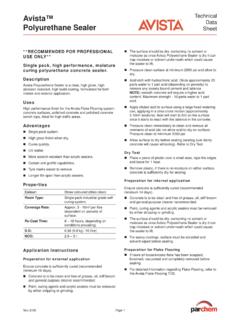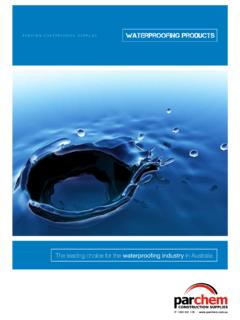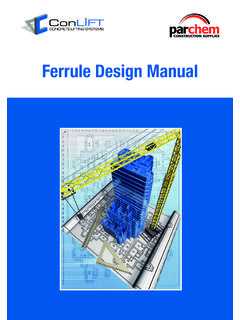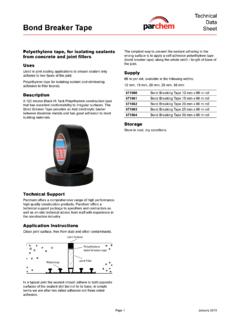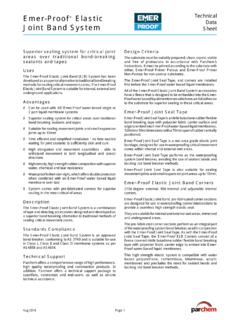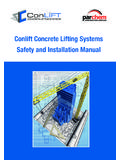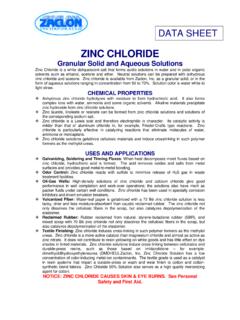Transcription of Fosroc Renderoc HB40 constructive solutions - …
1 constructive solutionsPage 1 Sept 2016 High performance, medium weight, very low shrinkage, patch repair mortarUsesFor the reinstatement of large areas of reinforced concrete where low permeability characteristics are required and where higher compressive strength is an important consideration. Renderoc hb40 has been engineered for the repair of columns and beams but, because of its relatively low fresh wet density, is also suitable for soffits and other overhead repair work. The mortar can also be used for small, localised patch repairs. Where compatibility with lower strength concrete is required, but low permeability and high-build characteristics are important, Renderoc HB25 should be used.
2 For higher strengths Renderoc HB70 should be hb40 is approved for use with Galvashield XP, with a resistivity <15,000 cm @ 28 Maximum compatibility with concrete of compressive strengths 30 - 45 MPa High-build applications possible while maintaining higher compressive strengths - fewer cold joints Frequently obviates the need for formwork Polymer-modification provides extremely low permeability to water, carbon dioxide and chlorides Exceptional system of shrinkage compensation provides long-term dimensional stability Can be applied quickly and efficiently by wet spraying One component, pre-bagged to overcome site-batched variations Contains no chloride admixtures Suitable for internal and external applications Potable water approved - complies to AS/NZS 4020:2005 DescriptionRenderoc hb40 concrete reinstatement mortar is supplied as a ready to use blend of dry powders which requires only the site addition of clean water to produce a highly consistent, medium-weight repair mortar.
3 It is based on Portland cements, graded aggregates, lightweight fillers and chemical additives which provide a mortar with good handling characteristics while minimising water demand. The low water requirement ensures good strength gain and long-term SupportParchem offers a technical support package to specifiers, end-users and contractors, as well as on-site technical CriteriaRenderoc hb40 exhibits a series of performance characteristics designed to achieve maximum compatibility with concrete with a compressive strength greater than 30 MPa. It is capable of being hand applied up to 40mm thick and wet spray applied up to 110mm thick in vertical ClausesHigh-build concrete reinstatement mortarThe reinstatement mortar shall be a single component polymer-modified, cement based blend of powders to which only the site-addition of clean water shall be permitted.
4 It shall be manufactured to achieve maximum compatibility with reinforced concrete with a compressive strength greater than 30 cured mortar shall achieve a compressive strength of 35 MPa at 28 days; a drying shrinkage of <400 microstrain at 7 days and <600 microstrain at 28 days and Flexural Strength of MPa @ 28 Renderoc hb40 Page 2constructive solutionsPropertiesThe following results were obtained at a water:powder ratio of and a temperature of 20 C unless otherwise MethodStandardEN 1504 R3 RequirementTest ResultCompressive StrengthEN 2190:1999AS - 2005 25 MPa-38 MPa @28 days10 MPa @ 1 day25 MPa @ 7 days35 MPa @ 28 daysBond strength by pull offEN 1542:1999 MPawithout MPaNitobond HAR MPaChloride ion ContentEN 1015-17:2000 AbsorptionEN 1307:2002 Kg/(m2 x ) Kg/(m x )Carbonation ResistanceEN 13295:2005d ref concreteConformCoefficient of thermal expansionEN 1770.
5 1990 Declared x 10-6 / CShrinkage and ExpansionEN 12617-4:2002> MPaShrinkage: MPaExpansion: MPaElastic ModulusEN 13412:2008> 15 GPaChloride DiffusionNordtest NT Build x 10-12 /secFlexural StrengthAS - MPa @ 28 daysTensile StrengthAS - MPa @ 28 daysSetting TimeAS - 1996-Initial Set: 3 hoursFinal Set: 5 hoursFresh Wet Density-1780 Kg/m Drying Shrinkage (25 x 25 x 285)prisms @ 23oC, 50% RH)AS - 2005-< 400 microstrains @ 7 days< 600 microstrains @ 28 daysAlkali reactive particlesRTA Rapid Mortar BarTest RTA T363-< (Non-Reactive)Build Characteristics achievable in a single layerOverheadVertical----Hand/Trowelup to 30mmup to 40mmWet Spray60-85mm70-110mmClarification of property values: The typical properties given above are derived from laboratory testing.
6 Results derived from field applied samples may Renderoc hb40 Page 3constructive solutionsApplication InstructionsPreparationSaw cut or cut back the extremities of the repair locations to a depth of at least 10 mm to avoid feather-edging and to provide a square edge. Break out the complete repair area to a minimum depth of 10 mm up to the sawn edge and 20mm behind any exposed reinforcement steel. Clean the surface and remove any dust, unsound or contaminated material, plaster, oil, paint, grease, corrosion deposits or algae. Where breaking out is not required, roughen the surface and remove any laitance by light scabbling or abrasive-blasting. Oil and grease deposits should be removed by steam cleaning, detergent scrubbing or the use of a proprietary degreaser.
7 The effectiveness of decontamination should then be assessed by a pull-off fully any corroded steel in the repair area and remove all loose scale and corrosion deposits. Steel should be cleaned to a bright condition where possible, paying particular attention to the back of exposed steel bars. Abrasive-blasting is recommended for this corrosion has occurred due to the presence of chlorides, the steel should be high-pressure washed with clean water immediately after abrasive-blasting to remove corrosion products from pits and imperfections within its steel primingApply one full coat of Nitoprime Zincrich and allow to dry before continuing. If any doubt exists about having achieved an unbroken coating, a second application should be made and, again, allowed to dry before continuing.
8 (If Galvashield XP are to be embedded into the Renderoc hb40 patch repair, refer to current Galvashield XP Technical Data Sheet for priming instructions). Substrate primingThe substrate should be thoroughly soaked with clean water and any excess removed prior to applying one coat of Nitobond HAR primer and scrubbing it well into the surface. Renderoc hb40 can be applied as soon as the primer becomes tacky. If the Nitobond HAR is too wet, overhead and vertical build up of the Renderoc hb40 mortar may be difficult. Scrubbing by hand a thin layer of the Renderoc into the tacky primer will assist adhesion and also minimise the chance of the primer drying out. If the Nitobond HAR primer dries before the application of the Renderoc , the area must be re-primed before exceptional circumstances, where a substrate/repair barrier is required or where the substrate is wet or likely to remain permanently damp, Nitobond EP bonding aid should be used.
9 Contact your local Parchem sales office for further : Nitobond HAR primer is not used when wet spraying Renderoc hb40 . Refer to the separate information document Wet Spraying Renderoc mortars available from Parchem Note: When Renderoc hb40 is used in conjunction with Impressed Current Cathodic Protection, the substrate bonding primer should be an OPC: Water slurry mixed at a 2:1 bonding agents should not be used. No steel primer should be applied. Please refer to Parchem for further should be taken to ensure that Renderoc hb40 is thoroughly mixed. A forced-action mixer is essential. Mixing at a slow speed (400/500 rpm) in a suitably sized drum using appropriate equipment such the Ransom 140 x 600 M14 Helical mixing paddle (product code: MH-MDR59) fitted to a heavy-duty 1600W mixer, such as Ransom 1602 E (product code: MH-EV160E) or equivalent is acceptable for one-bag mixes.
10 Free-fall mixers (cement mixers) must not be used. For normal applications, place - litres of drinking quality water into the mixer and, with the machine in operation, add 1 full 20 kg bag of Renderoc hb40 and mix for 3 - 5 minutes until fully homogeneous. Note that the powder must always be added to the water. Initially add litres of water, mix the product for a minimum 3 minutes to allow the polymers in the mix to activate; then make any necessary water adjustments after this time up to the maximum part bagsIt is recommended that full bags be mixed, however for applications where smaller quantities of product are required, experienced applicators may elect to mix half bags by weighing out 10kg of Renderoc hb40 and mixing with half the recommended quantity of water.
